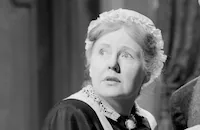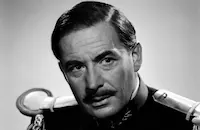When Thief Meets Thief
Cast & Crew
Raoul Walsh
Douglas Fairbanks
Valerie Hobson
Alan Hale
Jack Melford
Anthony Ireland
Film Details
Technical Specs

Synopsis
College student Ricky Morgan becomes involved in a boot-legging scheme by New Orleans underworld figure Jim Dial, who hatches a plot to cut his partner Chuck out of the racket. Chuck overhears the two talking and threatens Ricky, who punches him in the jaw. Chuck breaks his skull open in the fall, and part of Ricky's ring becomes embedded in his jaw. Dial snatches the ring from Ricky, and falsely accuses him of murder. Dial then blackmails Ricky into a series of burglaries. When the opportunity appears, Ricky escapes to London, where he continues in his new profession as a cat burglar. In Monte Carlo, golddigger Glory Howard discusses wedding plans with her fiancé, Sir Timothy Haddon, as he buys her a Ferranti diamond. At a gambling table, Glory sits next to respected stockbroker Colonel Fane, who offers her his lucky ring. When Haddon returns to their table, the casino manager questions him about a number of bad checks he has recently written, and Glory immediately turns her attentions to Fane. Back in London, the police question Sanders, a jeweler, about a missing diamond ring. After the police leave, Ricky enters the jewelry store and informs Sanders that the diamond once belonged to him. He is told that it is the property of Glory, now the fiancée of Fane, who has driven Haddon to bankruptcy and suicide. Ricky then discovers that Fane is actually Dial masquerading under an assumed name. Ricky breaks into Glory's apartment in an attempt to steal back his ring, but the young woman discovers him. Rather than turning the thief over to the police, however, Glory lets Ricky go free. Ricky learns that Glory is only interested in Dial for his money, and the two soon become lovers. They go to the British Museum, where he tells her the story of the ring. Thompson, Dial's best friend, follows them there, and when he accosts the couple, Ricky punches him. Glory attempts to end her engagement to Dial, but the gangster blackmails Glory into the marriage by threatening to turn Ricky over to the police on the old murder charge. On the day of the wedding, Ricky breaks into Dial's home, and forces the gangster to sign a confession. Dial pulls a gun on Ricky, who leaps upon him. Dial is shot in their struggle and dies. When the police arrive, Glory tells the police that it was a suicide, but she is instead accused of Dial's murder. Ricky goes to police and confesses to the deed, but no one believes that he could have made the jump from the roof of the house to the balcony. Ricky repeats his nearly impossible leap, but badly injures himself in the process. Now that the truth is known, Glory is acquitted, and she goes to the hospital to be with Ricky. With their crooked pasts behind them, Ricky and Glory start their new life together.

Director

Raoul Walsh
Cast

Douglas Fairbanks

Valerie Hobson

Alan Hale
Jack Melford
Anthony Ireland

Barbara Everest
Edward Rigby
Esme Percy

Basil Radford

Leo Genn
Ian Fleming
Frank Birch
Crew

Film Details
Technical Specs

Quotes
Trivia
Notes
The summary for this film is based on a continuity script found in the NYSA, and contemporary reviews. The working titles of this film were Forever and Ever and Thief in the Night. The film was released in Great Britain by United Artist under the title Jump for Glory. This was the third and final film by Douglas Fairbanks, Jr. for Criterion. According to his autobiography, Fairbanks had sought Greer Garson for the female lead in this film, but the producers of the play Mademoiselle, in which she was starring on the London stage at the time, refused to release her for this role.












